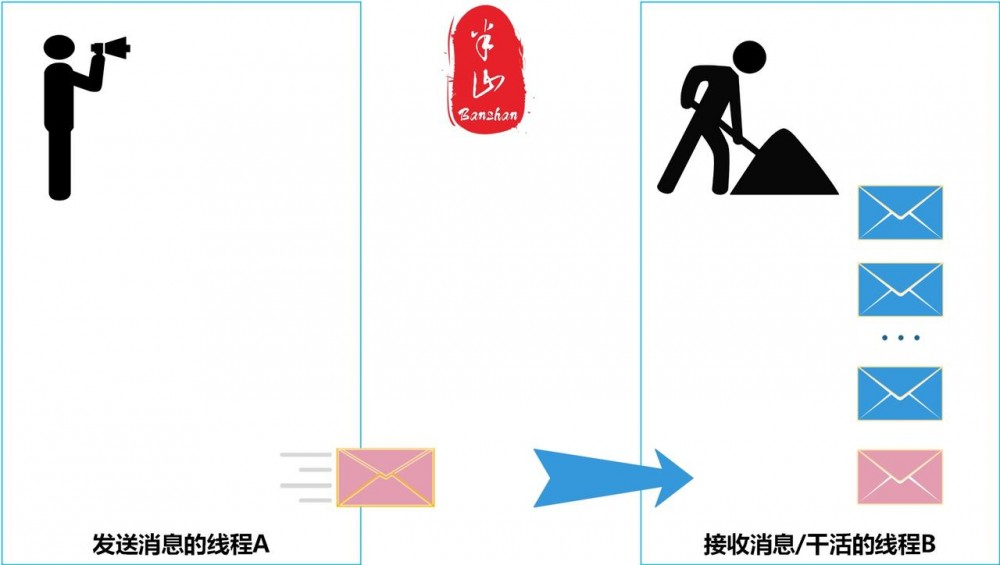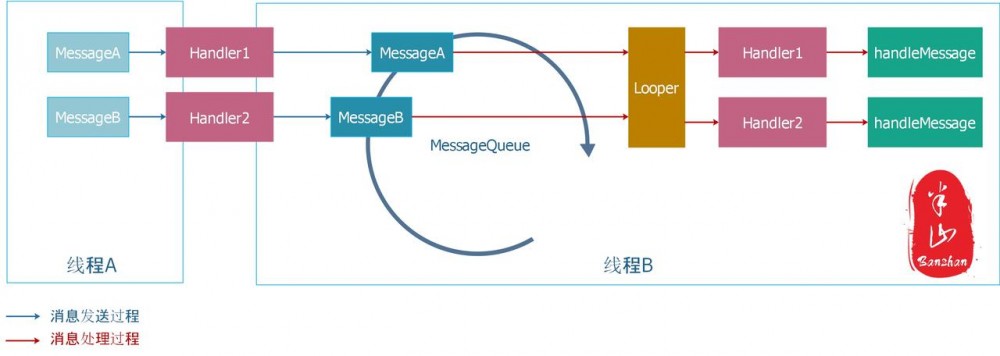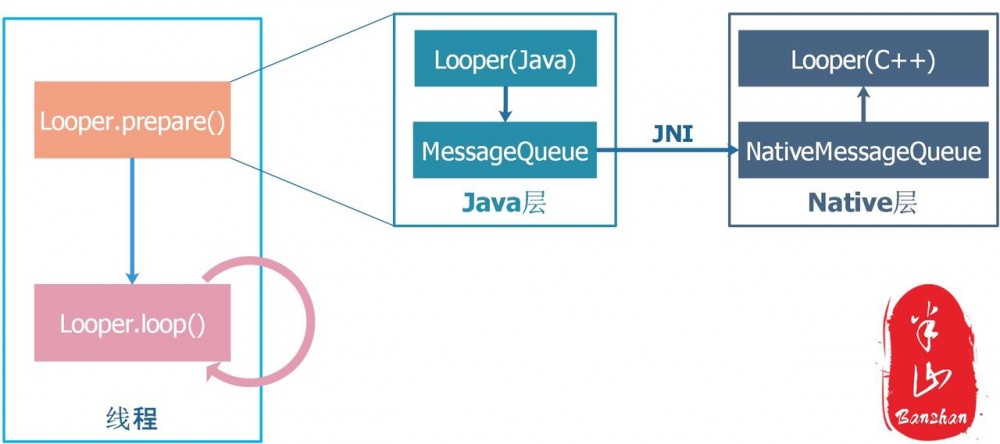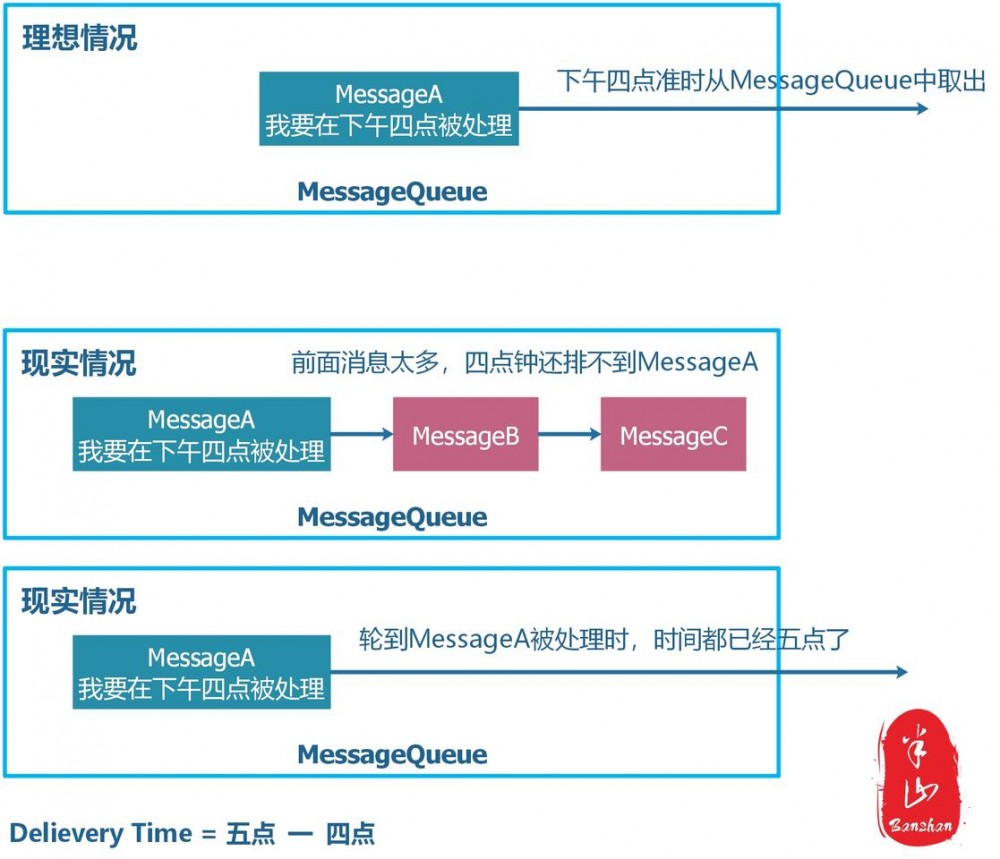Android消息机制
消息机制是Android中重要的线程间通信手段。
它的存在可以让一个线程通知另一个线程去工作。那么一个线程为什么会有让另一个线程工作的需求呢?
可以看一个常见的应用场景——UI更新。Google官方有一句话解释了UI更新的规则:The Android UI toolkit is not thread-safe and the view must always be manipulated on the UI thread。 因为UI更新并不是线程安全的,所以Android为了规避开发者可能的不安全操作,干脆将所有UI更新都放在了主线程中进行。在这种场景下,就会出现其他线程请求主线程来帮忙更新UI的需求。
除了UI更新,某些设计模式的实现也离不开消息机制。
下图便是消息机制最基本的工作方式。A线程发送消息到B线程的消息队列中,B线程不断从消息队列中取出新的消息进行处理。

线程A在这里表现的就像是一个甩手掌柜,只负责发送消息,却从不干活。而线程B就像是一个苦力,不断地处理到来的消息。
2 详细过程
下图便是消息机制的详细过程,主要分为两个部分:
- 消息发送过程
- 消息处理过程
消息通过Handler发送到另一个线程的MessageQueue中。另一个线程通过Looper不断轮询消息队列,取出其中的消息,并交给当初发送它的Handler进行处理。

上述详细过程有一个前提假设,也即线程B中存在Looper和MessageQueue。事实上,这两样东西并不是天生存在的。所以真正完整的详细过程包含以下三个部分:
- 消息队列准备过程
- 消息发送过程
- 消息处理过程
2.1 消息队列准备过程
在Android应用中,主线程自带Looper和MessageQueue,其他线程如果想具备消息机制的功能,则必须首先调用Looper.prepare()。
主线程为什么会自带Looper和MessageQueue呢?
所有Android应用的主线程都对应一个ActivityThread,正是由于所有Activity的回调方法都运行在主线程,所以Google便用ActivityThread来对应主线程。
ActivityThread的main方法是每个Android应用启动时的入口。通过6642行代码可知,主线程并非自带了Looper和MessageQueue,而是在ActivityThread的main方法中提前为我们创建好了而已。6642行创建了主线程的Looper和MessageQueue(下文有详述),6669行便开始了Looper的循环工作:不断从MessageQueue中取出消息并执行,消息队列为空时就将所在线程挂起休息,有新的消息到来时再起来继续工作。周而复始,永不停歇。
以上就是Android主线程的基本工作模型。至于我们所熟知的onCreate、onDestroy,其实背后也都是消息机制在起作用(当然还有Binder的身影)。
/frameworks/base/core/java/android/app/ActivityThread.java
6623 public static void main(String[] args) {
6624 Trace.traceBegin(Trace.TRACE_TAG_ACTIVITY_MANAGER, "ActivityThreadMain");
6625
6626 // CloseGuard defaults to true and can be quite spammy. We
6627 // disable it here, but selectively enable it later (via
6628 // StrictMode) on debug builds, but using DropBox, not logs.
6629 CloseGuard.setEnabled(false);
6630
6631 Environment.initForCurrentUser();
6632
6633 // Set the reporter for event logging in libcore
6634 EventLogger.setReporter(new EventLoggingReporter());
6635
6636 // Make sure TrustedCertificateStore looks in the right place for CA certificates
6637 final File configDir = Environment.getUserConfigDirectory(UserHandle.myUserId());
6638 TrustedCertificateStore.setDefaultUserDirectory(configDir);
6639
6640 Process.setArgV0("<pre-initialized>");
6641
6642 Looper.prepareMainLooper();
6643
6644 // Find the value for {@link #PROC_START_SEQ_IDENT} if provided on the command line.
6645 // It will be in the format "seq=114"
6646 long startSeq = 0;
6647 if (args != null) {
6648 for (int i = args.length - 1; i >= 0; --i) {
6649 if (args[i] != null && args[i].startsWith(PROC_START_SEQ_IDENT)) {
6650 startSeq = Long.parseLong(
6651 args[i].substring(PROC_START_SEQ_IDENT.length()));
6652 }
6653 }
6654 }
6655 ActivityThread thread = new ActivityThread();
6656 thread.attach(false, startSeq);
6657
6658 if (sMainThreadHandler == null) {
6659 sMainThreadHandler = thread.getHandler();
6660 }
6661
6662 if (false) {
6663 Looper.myLooper().setMessageLogging(new
6664 LogPrinter(Log.DEBUG, "ActivityThread"));
6665 }
6666
6667 // End of event ActivityThreadMain.
6668 Trace.traceEnd(Trace.TRACE_TAG_ACTIVITY_MANAGER);
6669 Looper.loop();
6670
6671 throw new RuntimeException("Main thread loop unexpectedly exited");
6672 }
复制代码
Looper.prepareMainLooper是一个静态方法,它的作用是为主线程创建一个Looper和MessageQueue。其最终调用了prepare方法,创建了一个新的Looper并将它写入sThreadLocal字段。
sThreadLocal字段是一个静态变量,按照常理它应该在内存中独一份,且各个线程均可访问的。但这里sThreadLocal利用了TLS(ThreadLocalStorage)的机制,每个线程访问到的sThreadLocal是相互独立的,并不是同一个。所以,主线程调用prepareMainLooper方法,相当于创建了一个线程独有的Looper,并且将这个Looper赋值给名为sMainLooper的静态变量(方便其他线程获取主线程的Looper)。
/frameworks/base/core/java/android/os/Looper.java
114 public static void prepareMainLooper() {
115 prepare(false);
116 synchronized (Looper.class) {
117 if (sMainLooper != null) {
118 throw new IllegalStateException("The main Looper has already been prepared.");
119 }
120 sMainLooper = myLooper();
121 }
122 }
复制代码
/frameworks/base/core/java/android/os/Looper.java
97 public static void prepare() {
98 prepare(true);
99 }
100
101 private static void prepare(boolean quitAllowed) {
102 if (sThreadLocal.get() != null) {
103 throw new RuntimeException("Only one Looper may be created per thread");
104 }
105 sThreadLocal.set(new Looper(quitAllowed));
106 }
复制代码

Looper的构造方法中会创建一个MessageQueue,所以调用Looper.prepare方法便会创建与线程唯一对应的Looper和MessageQueue。
/frameworks/base/core/java/android/os/Looper.java
267 private Looper(boolean quitAllowed) {
268 mQueue = new MessageQueue(quitAllowed);
269 mThread = Thread.currentThread();
270 }
复制代码
MessageQueue的构造方法如下,它会调用nativeInit方法在native层做一些初始化的工作。
/frameworks/base/core/java/android/os/MessageQueue.java
70 MessageQueue(boolean quitAllowed) {
71 mQuitAllowed = quitAllowed;
72 mPtr = nativeInit();
73 }
复制代码
63 private native static long nativeInit(); 复制代码
nativeInit对应的JNI方法为android_os_MessageQueue_nativeInit,其中创建了一个NativeMessageQueue对象,并将该对象的指针转化为long型传递给java层。在Android的世界中,存在大量java层对象和native层对象一一映射的关系,通常都是在java层对象中设立一个long型的字段,用于记录native对象的指针值。
/frameworks/base/core/jni/android_os_MessageQueue.cpp
172static jlong android_os_MessageQueue_nativeInit(JNIEnv* env, jclass clazz) {
173 NativeMessageQueue* nativeMessageQueue = new NativeMessageQueue();
174 if (!nativeMessageQueue) {
175 jniThrowRuntimeException(env, "Unable to allocate native queue");
176 return 0;
177 }
178
179 nativeMessageQueue->incStrong(env);
180 return reinterpret_cast<jlong>(nativeMessageQueue);
181}
复制代码
在NativeMessageQueue的构造函数中创建一个native层的Looper,并通过TLS的机制和线程绑定。
/frameworks/base/core/jni/android_os_MessageQueue.cpp
78NativeMessageQueue::NativeMessageQueue() :
79 mPollEnv(NULL), mPollObj(NULL), mExceptionObj(NULL) {
80 mLooper = Looper::getForThread();
81 if (mLooper == NULL) {
82 mLooper = new Looper(false);
83 Looper::setForThread(mLooper);
84 }
85}
复制代码
在native层Looper的构造过程中,67行的代码非常关键。它用于mWakeEventFd的初始化,创建出来的eventfd将会在rebuildEpollLocked函数中被epoll监听(151行)。Epoll机制是Linux内核中一种事件触发的机制,可以同时监听多个文件描述符。在调用epoll_wait将线程挂起的时候,如果有被监测的事件产生,则线程从挂起状态恢复,重新恢复运行。这其实是一种中断式的wait/notify机制。如果想了解这个机制的详细内容,可以参考这两篇博客: 博客1 和 博客2 。博客1中对epoll的基本概念讲述较多,博客2对epoll中的Level Trigger和Edge Trigger讲的非常清楚。
我们以149行到151行的代码为例,EPOLLIN表示监测mWakeEventFd上的可读事件,当该线程调用epoll_wait时,如果mWakeEventFd上有可读事件,则线程直接返回,否则挂起。在该线程挂起的时候,如果有其他线程往mWakeEventFd上写入新的数据,则该线程会接收到事件,并从挂起状态恢复为运行状态。
/system/core/libutils/Looper.cpp
63Looper::Looper(bool allowNonCallbacks) :
64 mAllowNonCallbacks(allowNonCallbacks), mSendingMessage(false),
65 mPolling(false), mEpollFd(-1), mEpollRebuildRequired(false),
66 mNextRequestSeq(0), mResponseIndex(0), mNextMessageUptime(LLONG_MAX) {
67 mWakeEventFd = eventfd(0, EFD_NONBLOCK | EFD_CLOEXEC);
68 LOG_ALWAYS_FATAL_IF(mWakeEventFd < 0, "Could not make wake event fd: %s",
69 strerror(errno));
70
71 AutoMutex _l(mLock);
72 rebuildEpollLocked();
73}
复制代码
/system/core/libutils/Looper.cpp
134void Looper::rebuildEpollLocked() {
135 // Close old epoll instance if we have one.
136 if (mEpollFd >= 0) {
137#if DEBUG_CALLBACKS
138 ALOGD("%p ~ rebuildEpollLocked - rebuilding epoll set", this);
139#endif
140 close(mEpollFd);
141 }
142
143 // Allocate the new epoll instance and register the wake pipe.
144 mEpollFd = epoll_create(EPOLL_SIZE_HINT);
145 LOG_ALWAYS_FATAL_IF(mEpollFd < 0, "Could not create epoll instance: %s", strerror(errno));
146
147 struct epoll_event eventItem;
148 memset(& eventItem, 0, sizeof(epoll_event)); // zero out unused members of data field union
149 eventItem.events = EPOLLIN;
150 eventItem.data.fd = mWakeEventFd;
151 int result = epoll_ctl(mEpollFd, EPOLL_CTL_ADD, mWakeEventFd, & eventItem);
152 LOG_ALWAYS_FATAL_IF(result != 0, "Could not add wake event fd to epoll instance: %s",
153 strerror(errno));
154
155 for (size_t i = 0; i < mRequests.size(); i++) {
156 const Request& request = mRequests.valueAt(i);
157 struct epoll_event eventItem;
158 request.initEventItem(&eventItem);
159
160 int epollResult = epoll_ctl(mEpollFd, EPOLL_CTL_ADD, request.fd, & eventItem);
161 if (epollResult < 0) {
162 ALOGE("Error adding epoll events for fd %d while rebuilding epoll set: %s",
163 request.fd, strerror(errno));
164 }
165 }
166}
复制代码
综上所述,一个可以处理消息的线程,必然会有一个唯一的Looper和唯一的MessageQueue。
2.2 消息发送过程
消息通过Handler进行发送。
通过调用Handler类的sendMessage方法,我们可以发送一个消息。sendMessage最终调用的是sendMessageAtTime方法。参数uptimeMillis表示希望消息发送的时间点距离开机时间点的毫秒数,譬如手机15:00:00开机,消息发送者希望这条消息15:00:01准时发送,那么传入的uptimeMillis就是1000。
/frameworks/base/core/java/android/os/Handler.java
602 public final boolean sendMessage(Message msg)
603 {
604 return sendMessageDelayed(msg, 0);
605 }
复制代码
662 public final boolean sendMessageDelayed(Message msg, long delayMillis)
663 {
664 if (delayMillis < 0) {
665 delayMillis = 0;
666 }
667 return sendMessageAtTime(msg, SystemClock.uptimeMillis() + delayMillis);
668 }
复制代码
689 public boolean sendMessageAtTime(Message msg, long uptimeMillis) {
690 MessageQueue queue = mQueue;
691 if (queue == null) {
692 RuntimeException e = new RuntimeException(
693 this + " sendMessageAtTime() called with no mQueue");
694 Log.w("Looper", e.getMessage(), e);
695 return false;
696 }
697 return enqueueMessage(queue, msg, uptimeMillis);
698 }
复制代码
sendMessageAtTime方法取出Handler的mQueue字段,并调用enqueueMessage方法。enqueueMessage的作用就是将消息加入到消息队列中。首先,将消息的target字段设置为发送时的Handler,表明这个消息被接收后依然由此Handler进行处理。其后根据Handler是否异步来决定发送的消息是否异步。最后调用MessageQueue的enqueueMessage方法。
/frameworks/base/core/java/android/os/Handler.java
740 private boolean enqueueMessage(MessageQueue queue, Message msg, long uptimeMillis) {
741 msg.target = this;
742 if (mAsynchronous) {
743 msg.setAsynchronous(true);
744 }
745 return queue.enqueueMessage(msg, uptimeMillis);
746 }
复制代码
745行的queue是从Handler的sendMessageAtTime方法中传递过来的,它是Handler对象的mQueue字段,在Handler对象的构造方法中被赋值。为了搞清楚mQueue的来及,我们有必要看一看Handler的构造方法。
2.2.1 消息被发送到哪个线程?
Handler的构造方法被重载了很多个,但底层其实都是这两个:
/frameworks/base/core/java/android/os/Handler.java
192 public Handler(Callback callback, boolean async) {
193 if (FIND_POTENTIAL_LEAKS) {
194 final Class<? extends Handler> klass = getClass();
195 if ((klass.isAnonymousClass() || klass.isMemberClass() || klass.isLocalClass()) &&
196 (klass.getModifiers() & Modifier.STATIC) == 0) {
197 Log.w(TAG, "The following Handler class should be static or leaks might occur: " +
198 klass.getCanonicalName());
199 }
200 }
201
202 mLooper = Looper.myLooper();
203 if (mLooper == null) {
204 throw new RuntimeException(
205 "Can't create handler inside thread " + Thread.currentThread()
206 + " that has not called Looper.prepare()");
207 }
208 mQueue = mLooper.mQueue;
209 mCallback = callback;
210 mAsynchronous = async;
211 }
复制代码
232 public Handler(Looper looper, Callback callback, boolean async) {
233 mLooper = looper;
234 mQueue = looper.mQueue;
235 mCallback = callback;
236 mAsynchronous = async;
237 }
复制代码
二者最大的区别就在于,一个传入了Looper,另一个没有传入Looper。
传入Looper的话,Handler对象的mQueue就等于looper.mQueue。假设Handler对象在线程A中创建,其构造时传入的是线程B的Looper,那么通过这个Handler发送的消息就将由线程B来处理。
没有传入Looper的话,Handler对象的mQueue就等于其创建线程的Looper。依然假设Handler对象在线程A中创建,此时构造Handler时没有传入Looper,那么通过这个Handler发送的消息就将由线程A来处理。
请仔细体会上述两种情况的区别。
针对没有传入Looper的情况,这里还要多提几句。Handler对象创建之后,由于它存在于Java堆上,所以可以被任何线程访问、使用。任何线程通过它发送的消息,最终都将汇总到其创建线程的MessageQueue中,包括在它的创建线程中发送消息。
下面看看MessageQueue的enqueueMessage方法做了哪些工作。
/frameworks/base/core/java/android/os/MessageQueue.java
536 boolean enqueueMessage(Message msg, long when) {
537 if (msg.target == null) {
538 throw new IllegalArgumentException("Message must have a target.");
539 }
540 if (msg.isInUse()) {
541 throw new IllegalStateException(msg + " This message is already in use.");
542 }
543
544 synchronized (this) {
545 if (mQuitting) {
546 IllegalStateException e = new IllegalStateException(
547 msg.target + " sending message to a Handler on a dead thread");
548 Log.w(TAG, e.getMessage(), e);
549 msg.recycle();
550 return false;
551 }
552
553 msg.markInUse();
554 msg.when = when;
555 Message p = mMessages;
556 boolean needWake;
557 if (p == null || when == 0 || when < p.when) {
558 // New head, wake up the event queue if blocked.
559 msg.next = p;
560 mMessages = msg;
561 needWake = mBlocked;
562 } else {
563 // Inserted within the middle of the queue. Usually we don't have to wake
564 // up the event queue unless there is a barrier at the head of the queue
565 // and the message is the earliest asynchronous message in the queue.
566 needWake = mBlocked && p.target == null && msg.isAsynchronous();
567 Message prev;
568 for (;;) {
569 prev = p;
570 p = p.next;
571 if (p == null || when < p.when) {
572 break;
573 }
574 if (needWake && p.isAsynchronous()) {
575 needWake = false;
576 }
577 }
578 msg.next = p; // invariant: p == prev.next
579 prev.next = msg;
580 }
581
582 // We can assume mPtr != 0 because mQuitting is false.
583 if (needWake) {
584 nativeWake(mPtr);
585 }
586 }
587 return true;
588 }
复制代码
跳过enqueueMessage方法中的异常判断,其核心的作用只有一个:将新消息加入MessageQueue中的消息链表中。MessageQueue中的Message通过链表的方式进行管理,其中的消息按照发送时间的先后顺序排列。在管理链表的过程中,只需持有头部对象就可以遍历所有的对象。因此MessageQueue只用了一个字段(mMessages)来记录消息链表的头部消息。
2.2.2 消息应该被插入到链表的什么位置?
557行和562行分别表示对新消息的两种处理方式,第一种是将新消息插入到链表头部,第二种是将新消息插入到链表中间(或尾部)。
先分析插入链表头部的情况。
- p == null 表示MessageQueue的消息链表为空,也即所有消息发送完毕,新加入的消息理所应当插入到头部。
- when == 0表示消息通过sendMessageAtTime方法发送,且传入的uptime为0,此类消息优先级最高,不管消息链表中是何种情况,新加入的消息都要插入到头部。
- when < p.when表示新消息预设的发送时间要早于现有头部消息的发送时间,根据时间越早越靠前的原则,新加入的消息要插入到头部。
除了插入到头部的三种情况外,其他情况下消息都将插入到链表中间(或尾部)。568行的for循环其实就是遍历消息链表,根据发送时间的先后顺序将消息插入到链表中。
2.2.3 消息加入链表后是否应该主动唤醒线程?
除了需要将新消息插入到链表的合适位置,enqueueMessage还要决定是否唤醒MessageQueue所在的线程。MessageQueue的mBlocked字段记录了其所属线程是否已经发生阻塞(被挂起),该字段在消息处理的过程中被赋值。
当新消息插入到链表头部时,needWake = mBlocked:
- 如果MessageQueue此时已经发生阻塞,则新消息插入头部时,需要唤醒阻塞线程,以便让它根据头部的新消息重新决定处理逻辑(可能是立即处理,也可能是延时处理)。
- 如果MessageQueue此时未发生阻塞,则新消息插入头部后无需做多余处理。它只需要静静地等在那里,线程处理完手中的消息后自然会同它碰面。
当新消息插入到链表中间(或尾部)时,needWake的赋值变得复杂起来。这主要是由于异步消息和同步屏障的存在。
同步屏障像是一个守卫,当消息链表的头部是一个同步屏障时,后续的同步消息都无法被放行,即便这些消息已经满足发送的时间要求。此时,链表上的异步消息却不受影响,它们照常按照发送时间的逻辑,顺利地被处理。
同步屏障是一种特殊的Message,它的target为null,表明这个消息是不需要被处理的,而普通消息的target都是最终来处理该消息的Handler。通过MessageQueue的postSyncBarrier方法可以放置同步屏障,只不过这个方法是hide的,而且从Android P开始,反射调用非 SDK 的接口被限制了。虽然网上有一些手段可以绕开这种限制,但Google的本意应该是不想让开发者再使用同步屏障了。与之对应,撤除同步屏障的方法是removeSyncBarrier。
/frameworks/base/core/java/android/os/MessageQueue.java
461 public int postSyncBarrier() {
462 return postSyncBarrier(SystemClock.uptimeMillis());
463 }
复制代码
465 private int postSyncBarrier(long when) {
466 // Enqueue a new sync barrier token.
467 // We don't need to wake the queue because the purpose of a barrier is to stall it.
468 synchronized (this) {
469 final int token = mNextBarrierToken++;
470 final Message msg = Message.obtain();
471 msg.markInUse();
472 msg.when = when;
473 msg.arg1 = token;
474
475 Message prev = null;
476 Message p = mMessages;
477 if (when != 0) {
478 while (p != null && p.when <= when) {
479 prev = p;
480 p = p.next;
481 }
482 }
483 if (prev != null) { // invariant: p == prev.next
484 msg.next = p;
485 prev.next = msg;
486 } else {
487 msg.next = p;
488 mMessages = msg;
489 }
490 return token;
491 }
492 }
复制代码
同步消息和异步消息的唯一差异在于Message的flag是否被置上 FLAG_ASYNCHRONOUS 标志位。这个标志位只在setAsynchronous方法中被改变。如果Handler的mAsynchronous为true,则通过该Handler发送的消息默认都是异步;反之,默认都是同步。除此以外,我们也可以通过消息的setAsynchronous方法来单独地给某个方法设置是否异步。
/frameworks/base/core/java/android/os/Message.java
447 public boolean isAsynchronous() {
448 return (flags & FLAG_ASYNCHRONOUS) != 0;
449 }
复制代码
477 public void setAsynchronous(boolean async) {
478 if (async) {
479 flags |= FLAG_ASYNCHRONOUS;
480 } else {
481 flags &= ~FLAG_ASYNCHRONOUS;
482 }
483 }
复制代码
回到新消息插入到链表中间(或尾部)时needWake的赋值,needWake在遍历之初被赋值如下:
/frameworks/base/core/java/android/os/MessageQueue.java
566 needWake = mBlocked && p.target == null && msg.isAsynchronous(); 复制代码
只有当MessageQueue所在的线程阻塞,链表头部为同步屏障,且新消息为异步消息时,needWake才为true。三者缺一不可。
- mBlocked为false,表明线程未阻塞,自然不需要唤醒。
- p.target != null,表明头部消息有效,此时即便mBlocked为true,这时候的阻塞也是有超时的,超时时间到达后,线程自动唤醒,无需外部唤醒。
- msg.isAsynchronous() = false,表明新消息为同步消息,此时若头部消息为同步屏障,则新消息也无法被放行,唤醒线程也没用,干脆不唤醒。
另外在遍历的过程中,如果发现新消息的前面有另一个消息为异步消息,则needWake重新置为false。这种情况表明原有的异步消息为线程设置了有超时的阻塞,当下时间未达到异步消息的发送时间,所以mBlocked为true。但由于此次阻塞设有超时,所以并不需要外不唤醒。
线程的阻塞相当于人类的睡眠,从阻塞状态中恢复有两种可能,一种是超时唤醒,另一个是外部唤醒。类比到人类的睡眠,人从睡梦中被叫醒也有两种可能,一种是自己定闹钟,闹钟响后将自己叫醒,另一种是被别人拍醒(不考虑自然醒,因为自然醒本质也是闹钟叫醒,只不过这个闹钟是生物钟)。
2.2.4 如何主动唤醒线程?
上面介绍了是否应该主动唤醒线程,如果回答“需要”的话,那我们又该怎样去唤醒线程呢?
/frameworks/base/core/java/android/os/MessageQueue.java
584 nativeWake(mPtr); 复制代码
通过nativeWake的native方法,我们就可以实现唤醒MessageQueue所在线程的目的。它对应的JNI方法是android_os_MessageQueue_nativeWake。传入的mPtr实际上是native对象的指针,它被存在一个Java的字段中,用于Java层和native层的互动。
mPtr被转换成NativeMessageQueue对象(c++对象)的指针,紧接着调用NativeMessageQueue对象的wake方法。
/frameworks/base/core/jni/android_os_MessageQueue.cpp
194static void android_os_MessageQueue_nativeWake(JNIEnv* env, jclass clazz, jlong ptr) {
195 NativeMessageQueue* nativeMessageQueue = reinterpret_cast<NativeMessageQueue*>(ptr);
196 nativeMessageQueue->wake();
197}
复制代码
再追踪下去,发现调用的是NativeMessageQueue中mLooper变量的wake方法。最终只干了一件事:往native层的Looper对象的mWakeEventFd中写一个“1”。结合2.1中对Epoll机制的描述,mWakeEventFd上有可读数据时,epfd将会监测到该事件,并将线程从挂起状态恢复为运行状态。
/frameworks/base/core/jni/android_os_MessageQueue.cpp
121void NativeMessageQueue::wake() {
122 mLooper->wake();
123}
复制代码
/system/core/libutils/Looper.cpp
398void Looper::wake() {
399#if DEBUG_POLL_AND_WAKE
400 ALOGD("%p ~ wake", this);
401#endif
402
403 uint64_t inc = 1;
404 ssize_t nWrite = TEMP_FAILURE_RETRY(write(mWakeEventFd, &inc, sizeof(uint64_t)));
405 if (nWrite != sizeof(uint64_t)) {
406 if (errno != EAGAIN) {
407 LOG_ALWAYS_FATAL("Could not write wake signal to fd %d: %s",
408 mWakeEventFd, strerror(errno));
409 }
410 }
411}
复制代码
2.3 消息处理过程
对于想要运行消息机制的线程而言,除了需要通过Looper.prepare来创建属于自己的Looper和MessageQueue,还需要调用Looper.loop来真正的轮询、处理消息。
/frameworks/base/core/java/android/os/Looper.java
127 public static Looper getMainLooper() {
128 synchronized (Looper.class) {
129 return sMainLooper;
130 }
131 }
132
133 /**
134 * Run the message queue in this thread. Be sure to call
135 * {@link #quit()} to end the loop.
136 */
137 public static void loop() {
138 final Looper me = myLooper();
139 if (me == null) {
140 throw new RuntimeException("No Looper; Looper.prepare() wasn't called on this thread.");
141 }
142 final MessageQueue queue = me.mQueue;
143
144 // Make sure the identity of this thread is that of the local process,
145 // and keep track of what that identity token actually is.
146 Binder.clearCallingIdentity();
147 final long ident = Binder.clearCallingIdentity();
148
149 // Allow overriding a threshold with a system prop. e.g.
150 // adb shell 'setprop log.looper.1000.main.slow 1 && stop && start'
151 final int thresholdOverride =
152 SystemProperties.getInt("log.looper."
153 + Process.myUid() + "."
154 + Thread.currentThread().getName()
155 + ".slow", 0);
156
157 boolean slowDeliveryDetected = false;
158
159 for (;;) {
160 Message msg = queue.next(); // might block
161 if (msg == null) {
162 // No message indicates that the message queue is quitting.
163 return;
164 }
165
166 // This must be in a local variable, in case a UI event sets the logger
167 final Printer logging = me.mLogging;
168 if (logging != null) {
169 logging.println(">>>>> Dispatching to " + msg.target + " " +
170 msg.callback + ": " + msg.what);
171 }
172
173 final long traceTag = me.mTraceTag;
174 long slowDispatchThresholdMs = me.mSlowDispatchThresholdMs;
175 long slowDeliveryThresholdMs = me.mSlowDeliveryThresholdMs;
176 if (thresholdOverride > 0) {
177 slowDispatchThresholdMs = thresholdOverride;
178 slowDeliveryThresholdMs = thresholdOverride;
179 }
180 final boolean logSlowDelivery = (slowDeliveryThresholdMs > 0) && (msg.when > 0);
181 final boolean logSlowDispatch = (slowDispatchThresholdMs > 0);
182
183 final boolean needStartTime = logSlowDelivery || logSlowDispatch;
184 final boolean needEndTime = logSlowDispatch;
185
186 if (traceTag != 0 && Trace.isTagEnabled(traceTag)) {
187 Trace.traceBegin(traceTag, msg.target.getTraceName(msg));
188 }
189
190 final long dispatchStart = needStartTime ? SystemClock.uptimeMillis() : 0;
191 final long dispatchEnd;
192 try {
193 msg.target.dispatchMessage(msg);
194 dispatchEnd = needEndTime ? SystemClock.uptimeMillis() : 0;
195 } finally {
196 if (traceTag != 0) {
197 Trace.traceEnd(traceTag);
198 }
199 }
200 if (logSlowDelivery) {
201 if (slowDeliveryDetected) {
202 if ((dispatchStart - msg.when) <= 10) {
203 Slog.w(TAG, "Drained");
204 slowDeliveryDetected = false;
205 }
206 } else {
207 if (showSlowLog(slowDeliveryThresholdMs, msg.when, dispatchStart, "delivery",
208 msg)) {
209 // Once we write a slow delivery log, suppress until the queue drains.
210 slowDeliveryDetected = true;
211 }
212 }
213 }
214 if (logSlowDispatch) {
215 showSlowLog(slowDispatchThresholdMs, dispatchStart, dispatchEnd, "dispatch", msg);
216 }
217
218 if (logging != null) {
219 logging.println("<<<<< Finished to " + msg.target + " " + msg.callback);
220 }
221
222 // Make sure that during the course of dispatching the
223 // identity of the thread wasn't corrupted.
224 final long newIdent = Binder.clearCallingIdentity();
225 if (ident != newIdent) {
226 Log.wtf(TAG, "Thread identity changed from 0x"
227 + Long.toHexString(ident) + " to 0x"
228 + Long.toHexString(newIdent) + " while dispatching to "
229 + msg.target.getClass().getName() + " "
230 + msg.callback + " what=" + msg.what);
231 }
232
233 msg.recycleUnchecked();
234 }
235 }
复制代码
159行开始的for循环在正常状态下永远不会退出,除非调用Looper或MessageQueue的quit方法。在每一次循环的过程中,都做了以下三件事:
- 取出消息链表中可被处理的头部消息。
- 执行消息所对应的Handler的dispatchMessage方法,并记录消息处理的delivery时间和dispatch时间,用于监测消息队列的运转状态是否正常。
- 回收此消息。
在这三个步骤中,需要详细分析的是1和2。1需要较多的篇幅来阐述,因此我们先分析2的过程。
2.3.1 Delievery Time和Dispatch Time分别指的是什么?
Delievery Time:

待发送的消息通常都有一个预设的发送时间点,也即message的when字段。当这个消息从消息链表中被取出时,记录另一个时间点,称之为dispatchStart。正常情况下,dispatchStart和msg.when相同,表明消息按照预设的时间点被取出。非正常情况下,如果前面消息处理时间过长,将会延误后续消息的发送(因为消息链表是串行发送的)。这个道理和排队的情形很相似。
DelieveryTime = dispatchStart - msg.when,表示消息被取出的时间点和预设的时间点之间的差距。差值较小,表明消息基本是按照预设的时间来取出的。差值较大,则表明消息队列有些拥堵,可能是前面的消息过多,也可能是前面某个消息的处理耗时过长。总之,当前这个消息并没有按照预设的时间被取出,而是有些滞后了。
Dispatch Time:
消息的处理时间,也即消息所对应Handler的dispatchMessage方法的运行时间。每个消息都有属于自己的处理方法,其中可能包含某些耗时操作。因此记录下dispatch time,当这个时间超过某个阈值时给出相应的警告,可以帮助开发者了解程序的性能以及运行时的压力。
2.3.2 消息处理最终执行哪个方法?
消息处理会调用Handler的dispatchMessage方法来对消息进行处理。在这个方法内部,我们可以看出一个消息会有三种处理方式。三种处理方式并非随机选择,而是具有一定的优先级的。
- 当message本身的callback字段不为空时,按照callback指定的方式对消息进行处理。
- 当条件1不满足,且Handler对象的mCallback字段不为空时,按照mCallback指定的方式对消息进行处理。
- 当条件1、2均不满足时,按照Handler类的handleMessage方法对消息进行处理。
/frameworks/base/core/java/android/os/Handler.java
97 public void dispatchMessage(Message msg) {
98 if (msg.callback != null) {
99 handleCallback(msg);
100 } else {
101 if (mCallback != null) {
102 if (mCallback.handleMessage(msg)) {
103 return;
104 }
105 }
106 handleMessage(msg);
107 }
108 }
复制代码
以下分别列举满足3种处理方式的例子:
- 当message本身的callback字段不为空时,按照callback指定的方式对消息进行处理。
/frameworks/base/core/java/android/speech/tts/TextToSpeechService.java
579 Runnable runnable = new Runnable() {
580 @Override
581 public void run() {
582 if (setCurrentSpeechItem(speechItem)) {
583 speechItem.play();
584 removeCurrentSpeechItem();
585 } else {
586 // The item is alreadly flushed. Stopping.
587 speechItem.stop();
588 }
589 }
590 };
591 Message msg = Message.obtain(this, runnable);
复制代码
- 当条件1不满足,且Handler对象的mCallback字段不为空时,按照mCallback指定的方式对消息进行处理。
/frameworks/base/services/core/java/com/android/server/GraphicsStatsService.java
110 mWriteOutHandler = new Handler(bgthread.getLooper(), new Handler.Callback() {
111 @Override
112 public boolean handleMessage(Message msg) {
113 switch (msg.what) {
114 case SAVE_BUFFER:
115 saveBuffer((HistoricalBuffer) msg.obj);
116 break;
117 case DELETE_OLD:
118 deleteOldBuffers();
119 break;
120 }
121 return true;
122 }
123 });
复制代码
- 当条件1、2均不满足时,按照Handler类的handleMessage方法对消息进行处理。
/frameworks/base/services/core/java/com/android/server/pm/ProcessLoggingHandler.java
35public final class ProcessLoggingHandler extends Handler {
......
......
47 @Override
48 public void handleMessage(Message msg) {
49 switch (msg.what) {
50 case LOG_APP_PROCESS_START_MSG: {
51 Bundle bundle = msg.getData();
52 String processName = bundle.getString("processName");
53 int uid = bundle.getInt("uid");
54 String seinfo = bundle.getString("seinfo");
55 String apkFile = bundle.getString("apkFile");
56 int pid = bundle.getInt("pid");
57 long startTimestamp = bundle.getLong("startTimestamp");
58 String apkHash = computeStringHashOfApk(apkFile);
59 SecurityLog.writeEvent(SecurityLog.TAG_APP_PROCESS_START, processName,
60 startTimestamp, uid, pid, seinfo, apkHash);
61 break;
62 }
63 case INVALIDATE_BASE_APK_HASH_MSG: {
64 Bundle bundle = msg.getData();
65 mProcessLoggingBaseApkHashes.remove(bundle.getString("apkFile"));
66 break;
67 }
68 }
69 }
复制代码
开发者定义的都是Handler的子类(譬如上面的ProcessingLoggingHandler),如果需要最终由Handler类的handleMessage来对消息进行处理,则子类中必须覆盖父类的handleMessage方法。否则将不会对消息进行处理,因为父类(Handler)的handleMessage方法是一个空方法。
这种阶梯式处理消息的设计,可以给予开发者更大的自由度。
2.3.3 如何取出下一个消息?
接下来重点讲述如何取出消息链表中可被处理的头部消息。让我们走进MessageQueue的next方法。
/frameworks/base/core/java/android/os/Looper.java
160 Message msg = queue.next(); // might block 复制代码
/frameworks/base/core/java/android/os/MessageQueue.java
310 Message next() {
311 // Return here if the message loop has already quit and been disposed.
312 // This can happen if the application tries to restart a looper after quit
313 // which is not supported.
314 final long ptr = mPtr;
315 if (ptr == 0) {
316 return null;
317 }
318
319 int pendingIdleHandlerCount = -1; // -1 only during first iteration
320 int nextPollTimeoutMillis = 0;
321 for (;;) {
322 if (nextPollTimeoutMillis != 0) {
323 Binder.flushPendingCommands();
324 }
325
326 nativePollOnce(ptr, nextPollTimeoutMillis);
327
328 synchronized (this) {
329 // Try to retrieve the next message. Return if found.
330 final long now = SystemClock.uptimeMillis();
331 Message prevMsg = null;
332 Message msg = mMessages;
333 if (msg != null && msg.target == null) {
334 // Stalled by a barrier. Find the next asynchronous message in the queue.
335 do {
336 prevMsg = msg;
337 msg = msg.next;
338 } while (msg != null && !msg.isAsynchronous());
339 }
340 if (msg != null) {
341 if (now < msg.when) {
342 // Next message is not ready. Set a timeout to wake up when it is ready.
343 nextPollTimeoutMillis = (int) Math.min(msg.when - now, Integer.MAX_VALUE);
344 } else {
345 // Got a message.
346 mBlocked = false;
347 if (prevMsg != null) {
348 prevMsg.next = msg.next;
349 } else {
350 mMessages = msg.next;
351 }
352 msg.next = null;
353 if (DEBUG) Log.v(TAG, "Returning message: " + msg);
354 msg.markInUse();
355 return msg;
356 }
357 } else {
358 // No more messages.
359 nextPollTimeoutMillis = -1;
360 }
361
362 // Process the quit message now that all pending messages have been handled.
363 if (mQuitting) {
364 dispose();
365 return null;
366 }
367
368 // If first time idle, then get the number of idlers to run.
369 // Idle handles only run if the queue is empty or if the first message
370 // in the queue (possibly a barrier) is due to be handled in the future.
371 if (pendingIdleHandlerCount < 0
372 && (mMessages == null || now < mMessages.when)) {
373 pendingIdleHandlerCount = mIdleHandlers.size();
374 }
375 if (pendingIdleHandlerCount <= 0) {
376 // No idle handlers to run. Loop and wait some more.
377 mBlocked = true;
378 continue;
379 }
380
381 if (mPendingIdleHandlers == null) {
382 mPendingIdleHandlers = new IdleHandler[Math.max(pendingIdleHandlerCount, 4)];
383 }
384 mPendingIdleHandlers = mIdleHandlers.toArray(mPendingIdleHandlers);
385 }
386
387 // Run the idle handlers.
388 // We only ever reach this code block during the first iteration.
389 for (int i = 0; i < pendingIdleHandlerCount; i++) {
390 final IdleHandler idler = mPendingIdleHandlers[i];
391 mPendingIdleHandlers[i] = null; // release the reference to the handler
392
393 boolean keep = false;
394 try {
395 keep = idler.queueIdle();
396 } catch (Throwable t) {
397 Log.wtf(TAG, "IdleHandler threw exception", t);
398 }
399
400 if (!keep) {
401 synchronized (this) {
402 mIdleHandlers.remove(idler);
403 }
404 }
405 }
406
407 // Reset the idle handler count to 0 so we do not run them again.
408 pendingIdleHandlerCount = 0;
409
410 // While calling an idle handler, a new message could have been delivered
411 // so go back and look again for a pending message without waiting.
412 nextPollTimeoutMillis = 0;
413 }
414 }
复制代码
首先分析326行的nativePollOnce方法,它的作用是设定下一次发送的时间或挂起线程。其对应的JNI方法为android_os_MessageQueue_nativePollOnce。内部调用NativeMessageQueue的pollOnce函数。
/frameworks/base/core/jni/android_os_MessageQueue.cpp
188static void android_os_MessageQueue_nativePollOnce(JNIEnv* env, jobject obj,
189 jlong ptr, jint timeoutMillis) {
190 NativeMessageQueue* nativeMessageQueue = reinterpret_cast<NativeMessageQueue*>(ptr);
191 nativeMessageQueue->pollOnce(env, obj, timeoutMillis);
192}
复制代码
NativeMessageQueue的pollOnce函数进一步调用Looper的pollOnce函数,并传入timeoutMills参数。
/frameworks/base/core/jni/android_os_MessageQueue.cpp
107void NativeMessageQueue::pollOnce(JNIEnv* env, jobject pollObj, int timeoutMillis) {
108 mPollEnv = env;
109 mPollObj = pollObj;
110 mLooper->pollOnce(timeoutMillis);
111 mPollObj = NULL;
112 mPollEnv = NULL;
113
114 if (mExceptionObj) {
115 env->Throw(mExceptionObj);
116 env->DeleteLocalRef(mExceptionObj);
117 mExceptionObj = NULL;
118 }
119}
复制代码
一层层往下走,发现最终调用的是Looper的pollInner函数,最终通过系统调用epoll_wait陷入内核态。
/system/core/libutils/Looper.cpp
242 int eventCount = epoll_wait(mEpollFd, eventItems, EPOLL_MAX_EVENTS, timeoutMillis); 复制代码
传入epoll_wait的timeoutMillis参数将直接决定epoll的行为。这里可以分为三种情况:
- timeoutMillis = 0,意味着无需等待。检测epfd上是否有事件,有或没有都将直接返回,继续执行后面的操作。
- timeoutMillis > 0,意味着epoll_wait有超时时间。对于Level Trigger的fd事件(这里是这种情况),在调用epoll_wait的时候会首先查看该事件是否已经存在。如果存在则直接返回,否则线程被挂起呈现阻塞状态,等待超时时间到达后恢复至运行状态。在超时等待的这段时间内,如果有新的消息被加入到链表头部,发送线程将会唤醒此线程以重新决定timeoutMillis的值。
- timeoutMillis = -1,epoll_wait会首先查看监测事件是否已经存在,如果存在则直接返回,否则将无限期地等待下去,直到有新消息到来,其他线程唤醒此线程。
通过320行可知,nextPollTimeoutMillis在第一次循环时被设置为0,意味着第一次循环将跳过epoll_wait的等待,直接去检查消息链表的状态。
/frameworks/base/core/java/android/os/MessageQueue.java
320 int nextPollTimeoutMillis = 0;
321 for (;;) {
322 if (nextPollTimeoutMillis != 0) {
323 Binder.flushPendingCommands();
324 }
325
326 nativePollOnce(ptr, nextPollTimeoutMillis);
复制代码
330-339行的主要工作是取出链表中第一个可被处理的消息。上文提到,MessageQueue只用了一个字段(mMessages)来记录消息链表的头部消息,所以通过332行便可以取到头部消息。如果链表头部是同步屏障,那么就要遍历去寻找链表中第一个异步消息。
/frameworks/base/core/java/android/os/MessageQueue.java
330 final long now = SystemClock.uptimeMillis();
331 Message prevMsg = null;
332 Message msg = mMessages;
333 if (msg != null && msg.target == null) {
334 // Stalled by a barrier. Find the next asynchronous message in the queue.
335 do {
336 prevMsg = msg;
337 msg = msg.next;
338 } while (msg != null && !msg.isAsynchronous());
339 }
复制代码
当取出的可处理消息为null时,意味着链表中暂时没有消息可以被处理,所以将nextPollTimeoutMillis置为-1,让next下一次轮询的时候直接通过epoll_wait将线程挂起休息。
反之则需要有进一步的处理,分两种情况讨论:
- 当下时间 < 该消息预定的处理时间,此时不应处理消息,需要等待时机成熟。于是将nextPollTimeoutMillis设置为当下时间和预定处理时间之间的差值,保证超时后能够再次轮询此消息,并进行相应处理。
- 当下时间 ≥ 该消息预定的处理时间,此时消息已经成熟,应该被处理。此时将mBlocked置为false,表明该线程处于Runnable状态,并且马上就要执行消息的处理方法。接着重构链表,将此消息从链表中删除。最后返回此消息到Looper的loop方法进行消息的实际处理。
/frameworks/base/core/java/android/os/MessageQueue.java
340 if (msg != null) {
341 if (now < msg.when) {
342 // Next message is not ready. Set a timeout to wake up when it is ready.
343 nextPollTimeoutMillis = (int) Math.min(msg.when - now, Integer.MAX_VALUE);
344 } else {
345 // Got a message.
346 mBlocked = false;
347 if (prevMsg != null) {
348 prevMsg.next = msg.next;
349 } else {
350 mMessages = msg.next;
351 }
352 msg.next = null;
353 if (DEBUG) Log.v(TAG, "Returning message: " + msg);
354 msg.markInUse();
355 return msg;
356 }
357 } else {
358 // No more messages.
359 nextPollTimeoutMillis = -1;
360 }
复制代码
2.3.4 IdleHandler有什么用?
在MessageQueue的next方法中,还会对IdleHandler进行处理。IdleHandler,顾名思义,表示线程空闲时才需要去执行的一些操作。如果此时链表头部的消息为空或尚未到达发送时间,则表明线程空闲,因此可以去处理一些杂事(IdleHandler里的工作)。
通过319行可知,pendingIdleHandlerCount最初始被赋值为-1。
/frameworks/base/core/java/android/os/MessageQueue.java
319 int pendingIdleHandlerCount = -1; // -1 only during first iteration 复制代码
所以第一次运行到371行时,pendingIdleHandlerCount必定小于0。通过373行到384行,将mIdleHandlers(类型为ArrayList)中的元素赋值给mPendingIdleHandlers(类型为数组)。之所以不直接使用mIdleHandlers来进行遍历,是因为遍历处理mIdleHandles时无需持有MessageQueue的monitor lock,于是干脆将锁释放,让其他线程可以在处理mPendingIdleHandlers中的元素时,同时往mIdleHandlers中插入新的元素。
如果不需要对IdleHandler处理,或者mIdleHandlers中没有需要处理的对象,则设置mBlocked为true(377行),在下一轮循环的过程中会通过epoll_wait将本线程挂起。需要注意的一点是,如果此次next()方法能够取出有效消息进行处理,代码是不会执行到371行及以下的位置,它会在355行直接返回。
接下来便是遍历mIdleHandlers中的元素,并执行它们的queueIdle方法的过程。如果queueIdle返回false,表明该IdleHandler只会执行一次,执行完之后就从mIdleHandlers列表中删除。
/frameworks/base/core/java/android/os/MessageQueue.java
371 if (pendingIdleHandlerCount < 0
372 && (mMessages == null || now < mMessages.when)) {
373 pendingIdleHandlerCount = mIdleHandlers.size();
374 }
375 if (pendingIdleHandlerCount <= 0) {
376 // No idle handlers to run. Loop and wait some more.
377 mBlocked = true;
378 continue;
379 }
380
381 if (mPendingIdleHandlers == null) {
382 mPendingIdleHandlers = new IdleHandler[Math.max(pendingIdleHandlerCount, 4)];
383 }
384 mPendingIdleHandlers = mIdleHandlers.toArray(mPendingIdleHandlers);
385 }
386
387 // Run the idle handlers.
388 // We only ever reach this code block during the first iteration.
389 for (int i = 0; i < pendingIdleHandlerCount; i++) {
390 final IdleHandler idler = mPendingIdleHandlers[i];
391 mPendingIdleHandlers[i] = null; // release the reference to the handler
392
393 boolean keep = false;
394 try {
395 keep = idler.queueIdle();
396 } catch (Throwable t) {
397 Log.wtf(TAG, "IdleHandler threw exception", t);
398 }
399
400 if (!keep) {
401 synchronized (this) {
402 mIdleHandlers.remove(idler);
403 }
404 }
405 }
406
407 // Reset the idle handler count to 0 so we do not run them again.
408 pendingIdleHandlerCount = 0;
409
410 // While calling an idle handler, a new message could have been delivered
411 // so go back and look again for a pending message without waiting.
412 nextPollTimeoutMillis = 0;
413 }
414 }
复制代码
- 本文标签: 删除 Security 模型 synchronized ssl find 数据 设计模式 value 详细分析 http queue id 构造方法 Dropbox tar 开发者 时间 消息队列 同步 DDL message 希望 静态方法 java UI 需求 Select final core Logging MQ ArrayList linux https 安全 代码 parse 锁 entity trigger IO 回答 struct cat Google 遍历 开发 src Job NIO token CST ip 压力 管理 Android 参数 ACE ORM 本质 tag shell 线程 CSS App REST lib 博客 Service bug retry db grep IDE CTO list build
- 版权声明: 本文为互联网转载文章,出处已在文章中说明(部分除外)。如果侵权,请联系本站长删除,谢谢。
- 本文海报: 生成海报一 生成海报二











![[HBLOG]公众号](https://www.liuhaihua.cn/img/qrcode_gzh.jpg)

